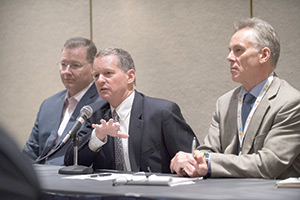Senior Reporter
Stronger Emissions Rules to Restrict Fleets From Repurposing Trucks, Experts Predict

This story appears in the May 9 print edition of Transport Topics.
LONG BEACH, Calif. — Vertical integration among truck makers will extend into emissions- and fuel-saving technologies in the future and ultimately could limit the number of available innovations, industry executives said.
Stronger emissions rules will restrict the opportunity to repurpose a truck within a fleet, they added.
The comments were made at a North American Council for Freight Efficiency session during the Advanced Clean Transportation Exposition here.
Bill Van Amburg, senior vice president of Calstart, said vertical integration within Class 8 manufacturers illustrated the need for a systems approach in meeting upcoming federal greenhouse-gas regulations.
But, Van Amburg added, “We might see less choice in combinations of systems that can actually achieve [the mandates]. And maybe there will be fewer options to vary from that.”
Calstart is a nonprofit organization focused on the growth of the clean transportation technology industry.
Van Amburg said original equipment manufacturers could become concerned with less-used technologies that “vary too far” and could spark compliance problems on a wider scale.
“OEMS could begin to ask themselves, ‘Gee, if I am going to do that for you, does it mean I am going to be under my [emissions] target so I’ll have to sell a whole bunch of something else that goes above the target?” he said.
Coming soon is the next step in Phase 1 of the federal greenhouse-gas rule, which is to tighten the maximum legal amount of carbon dioxide output from a truck. The rule mandated an initial reduction of carbon dioxide emissions and improvement in mileage standards by 3%, from a 2010 baseline, by January 2014. That rises another 3% with the upcoming second step in January.
Beyond that, the Environmental Protection Agency said the proposed Phase 2 standards, which would begin in model year 2021 — model year 2018 for trailers — would culminate in standards for model year 2027. EPA and the National Highway Traffic Safety Administration wrote the federal standard.
Elizabeth Fretheim, director of sustainability at Wal-Mart Stores Inc., said she wanted the greenhouse-gas regulations to be “technology pushing” but was concerned it could become “more and more difficult for some of these innovations to break into that market.”
Wal-Mart ranks No. 3 on the Transport Topics Top 100 list of the largest private carriers in North America.
Scott Perry, vice president of supply management and fleet management solutions at Ryder System Inc., said he also was concerned about vertical integration.
“Once you lose that flexibility [in specifying parts], you also lose some of the competitive factors that help drive the ongoing improvements in efficiency. So that is a risk we need to be very mindful of,” he said.
Ryder Supply Chain Solutions ranks No. 13 on the Transport Topics Top 100 list of the largest U.S. and Canadian for-hire carriers.
Kyle Treadway, president of Kenworth Sales Co. in Salt Lake City, which has 20 dealerships in Western states, said truck makers are keenly aware of where they are profitable and where they are not.
“So, if they can only produce 20 of a certain [emissions-reducing] configuration versus 200, you know where their investment is going to go. They are not going to innovate,” he said.
Treadway and Perry also noted the increasing complexity of meet- ing the emissions requirements appears to spell the end of repurposing, or cascading, a truck through duty cycles.
“That will not exist … because you are locked into a specific configuration. If you deviate from that from a duty-cycle standpoint, you can actually go backward from an efficiency standpoint and a reliability standpoint,” Perry said.
NACFE Executive Director Mike Roeth said that consequence has happened with downspeeding, or when the rear gear ratio is sped up in order to lower the speed of the engine to bring fuel-efficiency improvements when traveling at highway speeds.
“But [downspeeding] really puts a lot of torque on the driveline in start-and-stop, regional haul deliveries. We have examples of fleets who ran that truck longhaul during the day and at night in local deliveries and had driveline failures,” Roeth said.
Meanwhile, Perry pointed to the role of electronic logging devices as a likely means of monitoring emissions compliance, among its other functions.
ELDs, set to take effect in December 2017 and intended to address safety performance and monitor drivers’ hours of service, also will be a “huge catalyst” for connectivity, he said, citing vehicle-to-vehicle, vehicle-to-infrastructure, manufacturer-to-vehicle, driver-to-driver, customer-to-driver and customer- to-product.
Perry said ELDs used this way will “tie back” to emissions through monitoring performance of the vehicle, the engine and vehicle location.
“We are just scratching the surface on the impact it is going to have within the marketplace,” he said. “There are so many aspects of vehicle performance that will be completely transparent, and they will change the way we do business within the industry.”

